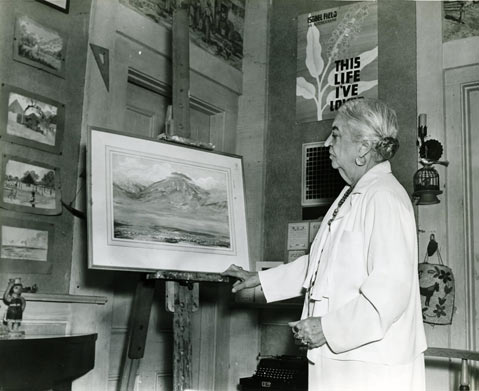
She was an artist and writer enfolded in a familial embrace of art and literature. Her mother was an artist, her brother a writer. Her stepfather was a world-renowned poet and novelist. Her first husband was an artist, her second a dramatist, and her son became a playwright. Her name was Isobel Field, a self-professed “lover of life.”
Isobel was born to Samuel and Frances “Fanny” Osbourne in Indianapolis in 1858. In the mid 1860s, mother and daughter made the trek over the Isthmus of Panama to join Samuel in the gold mining fields of Nevada. The family then moved further west and settled in East Oakland in 1866. In 1874, the new School of Design opened in San Francisco. Among its first students were Fanny and Isobel.
Samuel was away from his family for long stretches of time. At one point, they heard he had been killed in an Indian attack, although this rumor proved false. Samuel was also unfaithful, and the marriage deteriorated. In 1875, Fanny packed up her three children and sailed for Europe to continue art studies. While the family was in France, she met Robert Louis Stevenson, author of Treasure Island, Kidnapped, and The Strange Case of Dr. Jekyll and Mr. Hyde. After returning to northern California, she obtained a divorce and then married Stevenson in 1880.
The Stevensons eventually settled in Samoa in the hopes of restoring the writer’s delicate health. There, he penned some of his best work, including Treasure Island, written for his stepson, Lloyd, who later became a novelist and playwright.
Isobel married artist Joseph Strong in 1879. Their son, Austin, was born two years later. The couple lived for a time in Hawai‘i, where Strong executed landscapes commissioned by Joseph Spreckels, the sugar magnate. The Strongs became friends with King Kalakaua; Isobel designed a coat of arms for the royal family. Joseph Strong suffered a nervous breakdown, and he and Isobel eventually divorced.
Isobel took Austin to live with her mother and Stevenson in Samoa. Isobel became the author’s secretary for the last four years of his life. The Samoans named her “Teuila,” which means one who can bring beauty out of ugliness.
Stevenson died in 1894. Fanny traveled some, settled in San Francisco, then bought Stonehedge on Hot Springs Road in 1907. She also bought property on Oak Road and at Serena. Isobel would live on and off in all three homes for some 40 years. Isobel went on the lecture circuit, speaking about her work with Stevenson; she also wrote a number of magazine pieces.
Fanny Stevenson died in 1914, and shortly thereafter, Isobel married Edward Salisbury Field, who had been Fanny’s personal secretary. Isobel continued to paint, primarily landscapes, and began work on her autobiography. Her husband wrote a number of hit plays, such as Wedding Bells and Zander the Great. Austin became a successful playwright; the popular Seventh Heaven was later turned into a movie for which actress Janet Gaynor received an Oscar.
In 1937, Isobel’s autobiography, This Life I’ve Loved, was published, detailing her life up through her time in Samoa. The title was her husband’s idea. Sadly, he did not live to see the publication of the book. The autobiography was acclaimed the world over.
In 1947, Field, then 90, left her Serena home and moved into the El Mirasol Hotel, today the site of Alice Keck Park Memorial Gardens. Her health began to fail, and she died at El Mirasol at age 94 in 1953. The life she had loved had truly been a full one.



